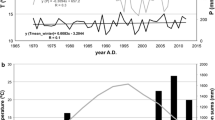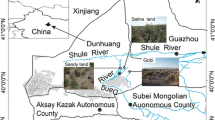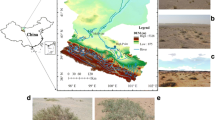Abstract
Plant species growing in shallow-soil habitat are likely to experience water deficit especially in seasonally dry or arid regions. However, only scarce studies focused on their water-use strategies. The current study aimed to reveal water-use strategies of different species growing on continuous dolomite outcrops (a typical shallow-soil habitat) in subtropical China that relied on different water sources, and to investigate the differences between narrow endemic and widespread species, based on season variations in leaf δ13C values. Leaf samples of six plant species (Radermachera sinica, Sapium rotundifolium, Sterculia euosma, Schefflera octophylla, Alchornea trewioides, and Vitex negundo, in different life-forms and leaf phenologies) were collected for carbon isotope measurements in the wet and dry seasons, respectively. Contrary to the expectation, the evergreen big shrub species, S. octophylla, which always relied on deep water sources, exhibited the most positive δ13C values (high water-use efficiency, WUE), indicating more conservative water-use strategies. While the two deciduous small shrubs, A. trewioides and V. negundo, which always relied on shallow water sources, exhibited the most negative δ13C values (low WUE). This result was associated with their short life spans, indicating an opportunistic water-use strategy. Leaf δ13C values of almost all (except for S. octophylla) the selected species were significantly (P < 0.05) higher in the dry season than in the wet season. This indicated that it was a common strategy for species in rocky karst habitat to improve their WUE in dry season. Despite the similar water sources utilized by the selected three tree species, the widespread one (R. sinica) exhibited greater improvement in leaf δ13C values than the narrow endemic ones (S. rotundifolium and S. euosma). This suggested that the widespread tree species had more flexible water-use strategies. It was further speculated that broad spatial distribution of widespread species may contribute to their highly plastic responses to changes in environmental conditions rather than always maintaining high WUE.




Similar content being viewed by others
References
Allen MF (2011) Linking water and nutrients through the vadose zone: a fungal interface between the soil and plant systems. J Arid Land 3:155–163
Bai E, Button TW, Liu F, Wu XB, Archer SR (2008) Variation in woody plant δ13C along a topoedaphic gradient in a subtropical savanna parkland. Oecologia 156:479–489
Baskin JM, Baskin CC (1988) Endemism in rock outcrop plant communities of unglaciated eastern United States: an evaluation of the roles of the edaphic, genetic and light factors. J Biogeogr 15:829–840
Bonal D, Sabatier D, Montpied P, Tremeaux D, Guehl JM (2000) Interspecific variability of δ13C among trees in rainforests of French Guiana: functional groups and canopy integration. Oecologia 124:454–468
Bornyasz MA, Graham RC, Allen AF (2005) Ectomycorrhizae in a soil-weathered granitic bedrock regolith: linking matrix resources to plants. Geoderma 126:141–160
Cao X, Jia JB, Li H, Li MC, Luo J, Liang ZS, Liu TX, Liu WG, Peng CH, Luo ZB (2012) Photosynthesis, water use efficiency and stable carbon isotope composition are associated with anatomical properties of the leaf and xylem in six polar species. Plant Biol 14:612–620
Chen SP, Bai YF, Lin GH, Han XG (2005) Variations in life-form composition and foliar carbon isotope discrimination among eight plant communities under different soil moisture conditions in the Xilin River Basin, Inner Mongolia, China. Ecol Res 20:167–176
Chen HS, Liu JW, Wang KL, Zhang W (2011) Spatial distribution of rock fragments on steep hillslopes in karst region of northwest Guangxi, China. Catena 84:21–28
Chen J, Chang SX, Anyia AO (2013) Physiological characterization of recombinant inbred lines of barley with contrasting levels of carbon isotope discrimination. Plant Soil 369:335–349
Cordell S, Goldstein G, Mueller-Dombois D, Webb D, Vitousek PM (1998) Physiological and morphological variation in Metrosideros polymorpha, a dominant Hawaiian tree species, along an altitudinal gradient: the role of phenotypic plasticity. Oecologia 113:188–196
Craven D, Hall JS, Ashton MS, Berlyn GP (2013) Water-use efficiency and whole-plant performance of nine tropical tree species at two sites with contrasting water availability in Panama. Trees Struct Funct 27:639–653
Damesin C, Rambal S, Joffre R (1997) Between-tree variations in leaf δ13C of Quercus pubescens and Quercus ilex among Mediterranean habitats with different water availability. Oecologia 111:26–35
Damesin C, Rambal S, Joffre R (1998) Seasonal and annual changes in leaf δ13C in two co-occurring Mediterranean oaks: relations of leaf growth and drought progression. Funct Ecol 12:778–785
Dawson TE, Ehleringer JR (1993) Gender-specific physiology, carbon isotope discrimination, and habitat distribution in boxelder, Acer negundo. Ecology 74:798–815
Ehleringer JR, Phillips SL, Comstock JP (1992) Seasonal variation in the carbon isotopic composition of desert plants. Funct Ecol 6:396–404
Estrada-Medina H, Graham RC, Allen MF, Jiménez-Osornio JJ, Robles-Casolco S (2012) The importance of limestone bedrock and dissolution karst features on tree root distribution in northern Yucatán, México. Plant Soil 362:37–50
Fan DY, Jie SL, Liu CC, Zhang XY, Xue XW, Zhang SR, Xie ZQ (2011) The trade-off between safety and efficiency in hydraulic architecture in 31 woody species in a karst area. Tree Physiol 31:865–877
Farquhar GD, Ehleringer JR, Hubich KT (1989) Carbon isotope discrimination and photosynthesis. Annu Rev Plant Physiol Plant Mol Biol 40:503–537
Francey RJ, Farquhar GD (1982) An explanation of 13C/12C variation in tree rings. Nature 297:28–31
Hasselquist NJ, Allen MF, Santiago LS (2010) Water relations of evergreen and drought-deciduous trees along a seasonally dry tropical forest chronosequence. Oecologia 164:881–890
Hopper SD, Brown AP, Marchant NG (1997) Plants of western Australian granite outcrops. J Roy Soc West Aust 80:141–158
Hubbert KR, Beyers JL, Graham RC (2001) Roles of weathered bedrock and soil in seasonal water relations of pinus Jeffreyi and Arctostaphylos patula. Can J For Res 31:1947–1957
Imbert E, Youssef S, Carbonell D, Baumel A (2012) Do endemic species always have a low competitive ability? A test for two Mediterranean plant species under controlled conditions. J Plant Ecol 5:305–312
Kloeppel BD, Gower ST, Treichel IW, Kharuk S (1998) Foliar carbon isotope discrimination in Larix species and sympatric evergreen conifers: a global comparison. Oecologia 114:153–159
Korol RL, Kirschbaum MUF, Farquhar GD, Jeffreys M (1999) Effects of water status and soil fertility on the C-isotope signature in Pinus radiate. Tree Physiol 19:551–562
Leffler AJ, Enqusit BJ (2002) Carbon isotope composition of tree leaves from dry tropical forests of Guancaste, Costa Rica: comparison across tropical ecosystems and tree life history. J Trop Ecol 18:151–159
Leffler AJ, Evans AS (2001) Physiological variation among Populus fremontii populations: short- and long-term relationships between δ13C and water availability. Tree Physiol 21:1149–1155
Liu CC, Liu YG, Guo K, Li GQ, Zheng YR, Yu LF, Yang R (2011) Comparative ecophysiological responses to drought of two shrub and four tree species from karst habitats of southwestern China. Trees Struct Funct 25:537–549
Lloyd KM, Lee WG, Wilson JB (2002) Competitive abilities of rare and common plants: comparisons using Aceena (Rosaceae) and Chionochloa (Poaceae) from New Zealand. Conserv Biol 16:975–985
Marshall JD, Zhang J (1994) Carbon isotope discrimination and water-use efficiency in native plants of the north-centural Rockies. Ecology 75:1887–1895
Matthes U, Larson DW (2006) Microsite and climatic controls of tree population dynamics: an 18-year study on cliffs. J Ecol 96:402–414
Mooney HA, Bullock SH, Ehleringer JR (1989) Carbon isotope ratios of plants of a tropical dry forest in Mexico. Funct Ecol 3:137–142
Moreno-Gutiérrez C, Dawson TE, Nicolás E, Querejeta JI (2012) Isotopes reveal contrasting water use strategies among coexisting plant species in a Mediterranean ecosystem. New Phytol 196:489–496
Nie YP, Chen HS, Wang KL, Tan W, Deng PY, Yang J (2011) Seasonal water use patterns of woody species growing on the continuous dolostone outcrops and nearby thin soils in subtropical China. Plant Soil 341:399–412
Nie YP, Chen HS, Wang KL, Yang J (2012) Water source utilization by woody plants growing on dolomite outcrops and nearby soils during dry seasons in karst region of Southwest China. J Hydrol 420:264–274
O’Leary MH (1981) Carbon isotope fractionation in plants. Phytochemistry 20:553–567
Osunkoya OO, Swanborough PW (2001) Reproductive and ecophysiological attributes of the rare Gardenia actinocarpa (Rubiaceae) compared with its common co-occurring congener G. ovularis. Aust J Bot 49:471–478
Peuke AD, Gessler A, Rennenberg H (2006) The effect of drought on C and N stable isotopes in different fractions of leaves, stems and roots of sensitive and tolerant beech ecotypes. Plant Cell Environ 29:823–835
Poot P, Hopper SD, van Diggelen MH (2012) Exploring rock fissures: does a specialized root morphology explain endemism on granite outcrops? Ann Bot 110:291–300
Porembski S, Barthlott W (2000) Granitic and geneissic outcrops (inselbergs) as centers of diversity for desiccation-tolerant vascular plants. Plant Ecol 151:19–28
Qu CM, Han XG, Su B, Huang JH, Jiang GM (2001) The characteristics of foliar δ13C values of plants and plant water use efficiency indicated by δ13C values in two fragmented rainforests in Xishuangbanna, Yunnan. Acta Botanica Sinica 43:186–192
Querejeta JI, Estrada-Medina H, Allen MF, Jiménez-Osornio JJ, Ruenes R (2006) Utilization of bedrock water by Brosimum alicastrum trees growing on shallow soil atop limestone in a dry tropical climate. Plant Soil 287:187–197
Resco V, Ferrio JP, Carreira JA, Calvo L, Casals P, Ferrero-Serrano A, Marcos E, Moreno JM, Ramírez DA, Sebastià MT, Valladares F, Williams DG (2011) The stable isotope ecology of terrestrial plant succession. Plant Ecol Divers 4:117–130
Sandquist DR, Ehleringer JR (2003) Carbon isotope discrimination differences within and between contrasting populations of Encelia farinosa raised under common-environment conditions. Oecologia 134:463–470
Scheiner SM (1993) Genetics and evolution of phenotypic plasticity. Annu Rev Ecol Syst 24:35–68
Schuster WSF, Sandquist DR, Phillips SL, Ehleringer JR (1992) Comparisons of carbon isotope discrimination in populations of aridland plant species differing in lifespan. Oecologia 91:332–337
Schwinning S (2010) The ecohydrology of roots in rocks. Ecohydrology 3:238–245
Schwinning S, Ehleringer JR (2001) Water use trade-offs and optimal adaptations to pulse-driven arid ecosystems. J Ecol 89:464–480
Snyder KM, Baskin JM, Baskin CC (1994) Comparative ecology of the narrow endemic Echinaceae tennesseensis and 2 geographically widespread congeners: relative competitive ability and growth characteristics. Int J Plant Sci 155:57–65
Song MH, Duan DY, Chen H, Hu QW, Zhang F, Xu XL, Tian YQ, Ouyang H, Peng CH (2008) Leaf δ13C reflects ecosystem patterns and responses of alpine plants to the environments on the Tibetan Plateau. Ecography 31:499–508
Stewart GR, Turnbull MH, Schmidt S, Erskine PD (1995) 13C natural abundance in plant communities along a rainfall gradient: a biological integrator of water availability. Aust J Plant Physiol 22:51–55
Tan WB, Wang GA, Han JM, Liu M, Zhou LP, Luo T, Cao ZY, Cheng SZ (2009) δ13C and water-use efficiency indicated by δ13C of different plant functional groups on Changbai Mountains, Northeast China. Chin Sci Bull 54:1759–1764
Tan W, Chen HS, Wang KL, Nie YP, Deng PY (2010) Differences in foliar carbon isotope ratio of dominant plant species in representative habitats on karst hill slopes of northwest Guangxi, China. Chin J Ecol 29:1709–1714
Walck JL, Baskin JM, Baskin CC (1999) Relative competitive abilities and growth characteristics of a narrowly endemic and a geographically widespread Solidago species (Asteraceae). Am J Bot 86:820–828
Wang ZQ, Newton M, Tappener II, John C (1995) Competitive relations between douglas-fir and pacific madrone on shallow soils in a Mediterranean climate. For Sci 41:744–757
Warren CR, McGrath JF, Adams MA (2001) Water availability and carbon isotope discrimination in conifers. Oecologia 127:476–486
Williams PW (2008) The role of the epikarst in karst and cave hydrogeology: a review. Int J Speleol 37:1–10
Wright IJ, Reich PB, Westoby M, Ackerly DD, Baruch Z, Bongers F, Cavender-Bares J, Chapin T, Cornelissen JHC, Diemer M, Flexas J, Garnier E, Groom PK, Gulias J, Hikosaka K, Lamont BB, Lee T, Lee W, Lusk C, Midgley JJ, Navas M-L, Niinemets U, Oleksyn J, Osada N, Poorter H, Poot P, Prior L, Pyankov VI, Roumet C, Thomas SC, Tjoelker MG, Veneklaas EJ, Villar R (2004) The worldwide leaf economics spectrum. Nature 428:821–827
Zhang JW, Marshall JD (1995) Variation in carbon isotope discrimination and photosynthetic gas exchange among populations of Pseudotsuga menziesii and Pinus ponderosa in different environment. Funct Ecol 9:402–412
Zhang JW, Feng Z, Cregg BM, Schumann CM (1997) Carbon isotopic composition, gas exchange, and growth of three populations of ponderosa pine differing in drought tolerance. Tree Physiol 17:461–466
Zhu SQ (1997) Ecological Research on Karst Forest (II). Guizhou Science and Technology Press, Guiyang
Zwieniecki MA, Newton M (1995) Roots growing in rock fissures: their morphological adaptation. Plant Soil 172:181–187
Zwieniecki MA, Newton M (1996) Seasonal pattern of water depletion from soil-rock profiles in a Mediterranean climate in southwestern Oregon. Can J Forest Res 26:1346–1352
Acknowledgments
This research was supported by the Chinese Academy of Sciences Action Plan for Development of Western China (KZCX2-XB3-10), the National Natural Science Foundation of China (31100294 and 41171187), the “Western Light” Program of Talent Cultivation of the Chinese Academy of Sciences and the Knowledge Innovation Program (ISACX-LYQY-QN-1201) of the Chinese Academy of Sciences.
Author information
Authors and Affiliations
Corresponding author
Additional information
Communicated by L. Bavaresco.
Rights and permissions
About this article
Cite this article
Nie, Yp., Chen, Hs., Wang, Kl. et al. Seasonal variations in leaf δ13C values: implications for different water-use strategies among species growing on continuous dolomite outcrops in subtropical China. Acta Physiol Plant 36, 2571–2579 (2014). https://doi.org/10.1007/s11738-014-1628-3
Received:
Revised:
Accepted:
Published:
Issue Date:
DOI: https://doi.org/10.1007/s11738-014-1628-3




